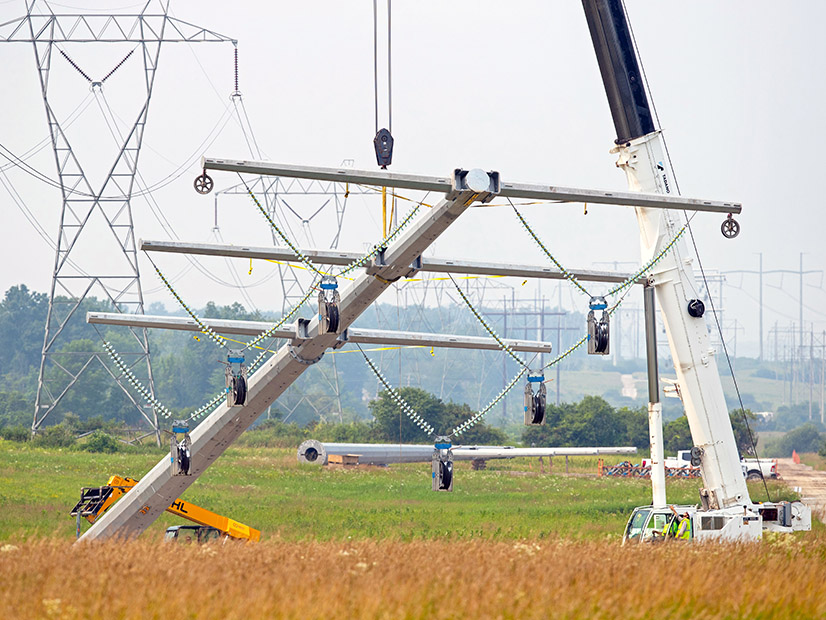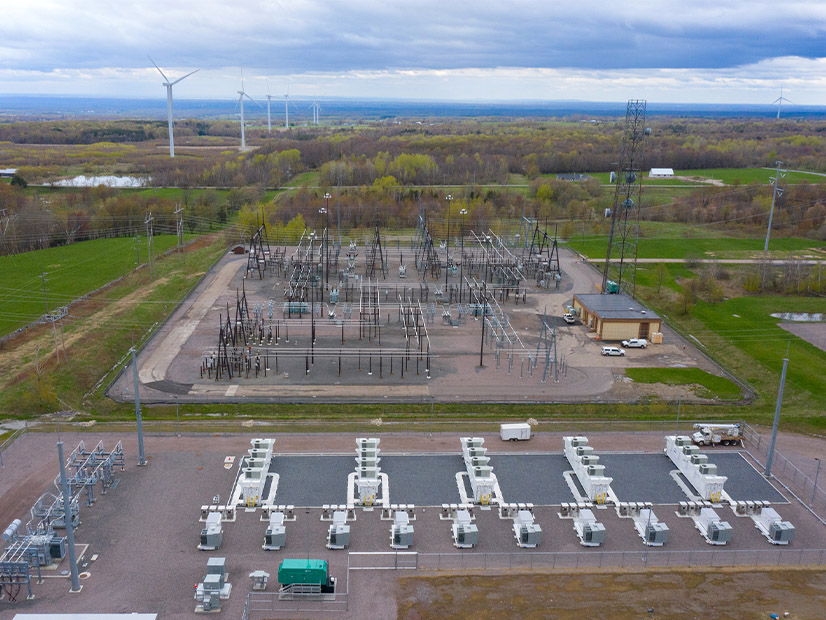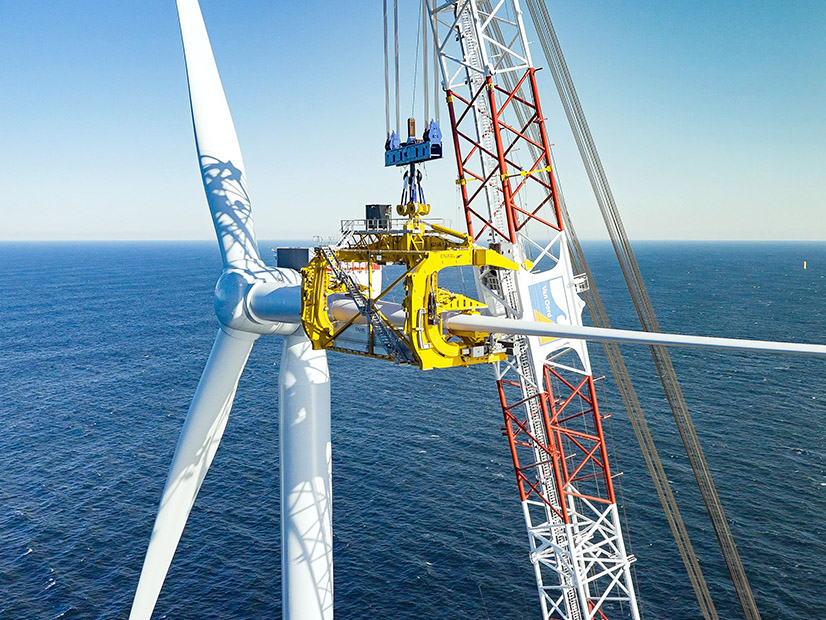
The organizations charged with leading New York’s energy transition enter 2024 trying to build on momentum generated in the past year while recovering from its disappointments.
The state celebrated its first offshore wind generation and the first coordinated grid planning process while adding 6.4 GW of new renewable energy contracts.
But it also suffered some notable setbacks, as financial pressures endangered many of the renewable projects that had been contracted but not yet constructed. And the federal government passed over New York as it was allocating multibillion-dollar funding packages for hydrogen hubs.
And as the addition of renewable generation threatens to fall behind fossil plant retirements, NYISO issued increasingly dire warnings about capacity shortfall while the Public Service Commission opened a discussion on expanding the definition of “zero emissions” resources beyond wind, solar and storage. (See NY Renewable Portfolio May Come up Short on Getting to Net Zero.)
But state leaders remain committed in word and deed to the clean energy transition and to the generation and transmission projects that will make it a reality.
The Climate Leadership and Community Protection Act (CLCPA) mandates that New York reduce its emissions to 85% below 1990 levels by 2050 and achieve 70% renewable electricity by 2030 and 100% zero-emission electricity by 2040.
At the start of 2023, New York celebrated both the completion of the Climate Action Council’s Scoping Plan, which provided a road map to achieve the CLCPA’s mandates, and the election of Gov. Kathy Hochul on a clean energy agenda. (See Scoping Plan ‘Sets Course’ for NY Climate Goals, Raises Questions.)
Below, NetZero Insider and RTO Insider outline what’s on the horizon in 2024 for NYISO and the three agencies central to the state’s climate efforts.
Public Service Commission
PSC Chair Rory Christian said the additional megawatts of power New York will need to meet its electrification goals mean transmission development is paramount. And it is well underway, with billions of dollars authorized for line construction.
“I don’t imagine we’ll have a lot of transmission items coming to us in 2024, but the process is a multiyear, ongoing thing, and we’ll be heavily involved in moving that forward,” he said.
He flagged New York’s first-ever coordinated grid planning process — approved by the PSC in August as a way to increase the speed and control the cost of building transmission — as one of the most significant achievements of 2023.
Also important were proactive transmission projects planned to meet future demand.
“Ensuring that those assets are built out affordably and expeditiously, that’s going to pay huge dividends in the long run,” Christian said.
“A lot of the work that we do is long-term. We issue an order, and the fruition of that may be years in the making. I look at this transmission work — I think we’re over $6 billion at this point in transmission investments that we’ve authorized this year — as probably the single most significant of the actions that we have taken.”
The Champlain Hudson Power Express, which was proposed in 2010, finally began underground construction in 2023 and promises to deliver up to 1,250 MW of emissions-free power to New York City starting in 2026.
New York Power Authority
Transmission also figured prominently for the New York Power Authority in 2023. It completed and energized major upgrades of the Smart Path and Central East Energy Connect projects, both of which will help move more power from upstate to downstate, where emissions-free power generation is in short supply.
In 2024, NYPA and its private-sector partners expect to start construction of the 175-mile underground power line that is the heart of Clean Path NY, an $11 billion package of upstate renewable energy projects linked to New York City. In the spring of 2023, a 104-MW wind farm became the first Clean Path generation asset to come online.
Perhaps the most far-reaching development for NYPA in 2023 was a contentious piece of legislation that expanded its role as a renewable energy developer.
NYPA spent the second half of 2023 gathering input on how to approach its new responsibilities and in 2024 will begin planning how to use those new powers, with plans to publish its renewable energy generation strategic plan in 2025. “We are fully engaged in embracing our expanded authority, and the entire organization is galvanized behind our commitment,” NYPA President Justin Driscoll said via email.
Along the way, NYPA will continue with the multiple smaller-scale projects it has been assisting, including high-speed chargers for light-duty vehicles, energy storage, environmental justice, building decarbonization, energy efficiency, distributed energy resources and heavy-duty chargers for electric city buses.
One milestone example in 2023: It cut the ribbon on the first utility-scale battery asset owned by the state, the 20-MW Northern New York Energy Storage Project.
These smaller projects can easily be overshadowed by the high-megawatt, high-dollar projects that command so much attention, but the small projects far outnumber the large-scale projects. Smaller-scale projects also serve to make the energy transition more tangible to people who may never see an industrial-scale wind farm.
NYSERDA
About those wind farms …
2023 will be remembered as the year that planning for multiple offshore wind projects off the Northeast U.S. coast came to a screeching halt, squeezed by contracts that locked in revenue with no provision for an inflation adjustment.
Developers of four New York OSW projects said they could not proceed to construction under their current financial agreements with the state. On Jan. 3, 2024, Empire Wind 2 became the first New York project to cancel its contract. The project itself remains alive, and developers are seeking other ways to move forward with it. (See Empire Wind 2 Cancels OSW Agreement with New York.) Many of New York’s onshore wind and solar projects are in the same predicament. The situation came to a head in June, when developers of 90 projects totaling more than 12 GW sought additional compensation.
The PSC rejected the request in mid-October. That day, Gov. Hochul issued a 10-point plan to accelerate renewable energy development, although the plan was mostly a reaffirmation of existing policies and programs.
The urgency Hochul’s plan promised has been backed up with actions so far: In late October, the governor announced conditional contracts for 6.4 GW of renewable generation. In late November, the New York State Energy Research and Development Authority (NYSERDA) issued an expedited solicitation that will allow developers of those struggling earlier projects to rebid at a higher cost in early 2024.
A NYSERDA spokesperson said awards for offshore wind and Tier 1 onshore renewables projects from the agency’s expedited solicitations are expected in February 2024 and April 2024, respectively.
Also on the 2024 agenda for NYSERDA: expanding the electric school bus fleet; designing a program to distribute $317 million in home energy and electrification rebates; assessing the role of nuclear power, green hydrogen and other zero-emissions technologies in the state’s clean energy transition; continued development of a cap-and-invest program; and helping allocate $400 million in competitive federal solar grants.
NYISO
NYISO has been among the most vocal groups in raising concerns about maintaining reliability during the clean energy transition. (See NYISO CEO Warns of Tightening Resource Adequacy.)
In November, the ISO announced it would keep four natural gas peaker plants operational in New York City to address a 446-MW reliability deficit. The units were set to retire in May 2025 to comply with the Department of Environmental Conservation’s 2019 Peaker Rule, which imposes nitrogen oxide emissions limits on fossil fuel plants. (See NYISO to Keep Gas Peakers Online to Solve NYC Reliability Need.)
“From an operations perspective, the resources are not coming in as fast as they were originally planning to, as seen with OSW,” said Rick Gonzales, who recently retired as the ISO’s chief operating officer.
Gonzales was cautious about New York’s progress in meeting CLCPA goals, saying, “so far so good, but it’s very early in the process.” He added, “Legacy fossil fuel resources should not be retired until we have new replacement clean energy resources in place.”
Much of the concern stems from the nearly 3 GW backlog in the ISO’s interconnection queue. To comply with FERC Order 2023, the ISO is planning to move to a clustered study process, with increased penalties for projects that fail to meet milestones and more opportunities for projects to exit the queue without hindering the progress of other queued projects. Stakeholders have expressed concerns over the ISO’s proposed deposit requirements and the length of time to make project decisions. (See NYISO Stakeholders Question Proposed Interconnection Timelines, Deposit Rules.)
On a positive note, the ISO has seen an increase in renewable projects entering its interconnection queue. The 2023 class year began with nearly 100 projects, many renewable — a notable rise from the previous class year, which saw 53 projects, with only 27 being clean energy projects. (See NYISO Begins 2023 Class Year with Nearly 100 Projects.)
The ISO also has been working to increase its demand-side resources (DSRs), such as DERs, which the CLCPA says are vital to providing “a more flexible and resilient grid to address and mitigate the impacts of climate change.”
In December, the ISO announced the state had surpassed 5,000 MW of behind-the-meter solar capacity, halfway to the CLCPA goal of 10,000 MW of distributed solar by 2030.
Over the past year, NYISO has been developing rules to make New York’s markets more accommodating to DSRs.
Some stakeholders, however, have criticized the ISO’s proposals, including its 10-kW minimum requirement for DER aggregation participation and its proposed day-ahead market for some DSRs, as cost prohibitive and counterproductive. (See NYISO Stakeholders Balk at Proposed Day-Ahead Market for Demand Resources.)
The ISO’s agenda for the upcoming year is packed with projects, including dynamic reserves and capacity accreditation modeling improvements, resetting the demand curve and improving emissions transparency. However, its primary focus will be on improving the interconnection queue and integrating more renewable energy into the grid to address potential near-term reliability shortfalls.
Building on Experience
PSC Chair Christian said absent the extraordinary challenges of the early 2020s — war, disease, inflation, interest rates — projects now struggling through pre-construction development phases would have been able to progress much more easily.
Christian said the land-based renewables the state had previously authorized created a partial template for New York’s first offshore wind projects. In December, South Fork Wind became the nation’s first utility-scale project in federal waters to send power to the mainland grid.
South Fork, in turn, smooths the path for the thousands more megawatts New York wants to generate offshore, Christian said.
“Every single time we do one of these projects, it makes the process easier going forward,” Christian said. “It’s not just the interface with the federal government. It’s everything from the legal agreements, the contractual terms, the procurement documents, the RFPs, the insurance requirement, the bonding.”
Real and Perceived Costs
The high cost of the energy transition — and the allocation of that cost — also comes to fore in a state with some of the highest electricity rates in the nation.
The PSC’s staff in July 2023 tallied $44 billion in spending authorized since passage of the CLCPA in 2019. It offered no estimate how many billions more would be needed.
Christian said he chafes at criticism of the cost of the energy transition.
New York’s electric and gas infrastructure would need major investments even if it were not going through a transition, he said. Business as usual might cost just as much as building clean energy infrastructure, he added, and it would bring none of the societal and environmental benefits.
But there are ways to minimize spending, and the PSC does pursue them, Christian said. He singled out the Brooklyn Queens Demand Management (BQDM) program as an example.
In 2013, Con Edison identified growing demand overload in a central swath of New York City’s two most populous boroughs that could reach 69 MW within five years. The new substation, switching station and feeders needed to meet this demand were estimated to cost $1 billion.
This would become the first case in which the PSC required a utility to attempt to address demand through nontraditional means. In late 2014, the PSC authorized Con Edison to deploy distributed generation and demand-side management to defer installation of the substation, with a budget capped at $200 million.
In its third-quarter 2023 report, Con Edison said expenditures to date stood at $131.3 million and peak-hour load relief had reached 61.2 MW.
“It’s been almost 10 years — that substation is still working just fine,” Christian said. “It may get upgraded at some point — in fact, it likely will. But that saved ratepayers a significant amount of money.”
The other thing BQDM did was buy time for technology development.
“Time is our friend in this scenario in many ways,” Christian said.
“I think about just the advancements we’ve seen in battery storage. They’re now an effective solution, where just 10 years ago they were marginal in many instances. The same applies for advances in charging stations, inverter technology, the list goes on and on.
“I see every reason to be optimistic about the pace of technology going forward in helping address many of the needs that we’re seeing coming up.”



